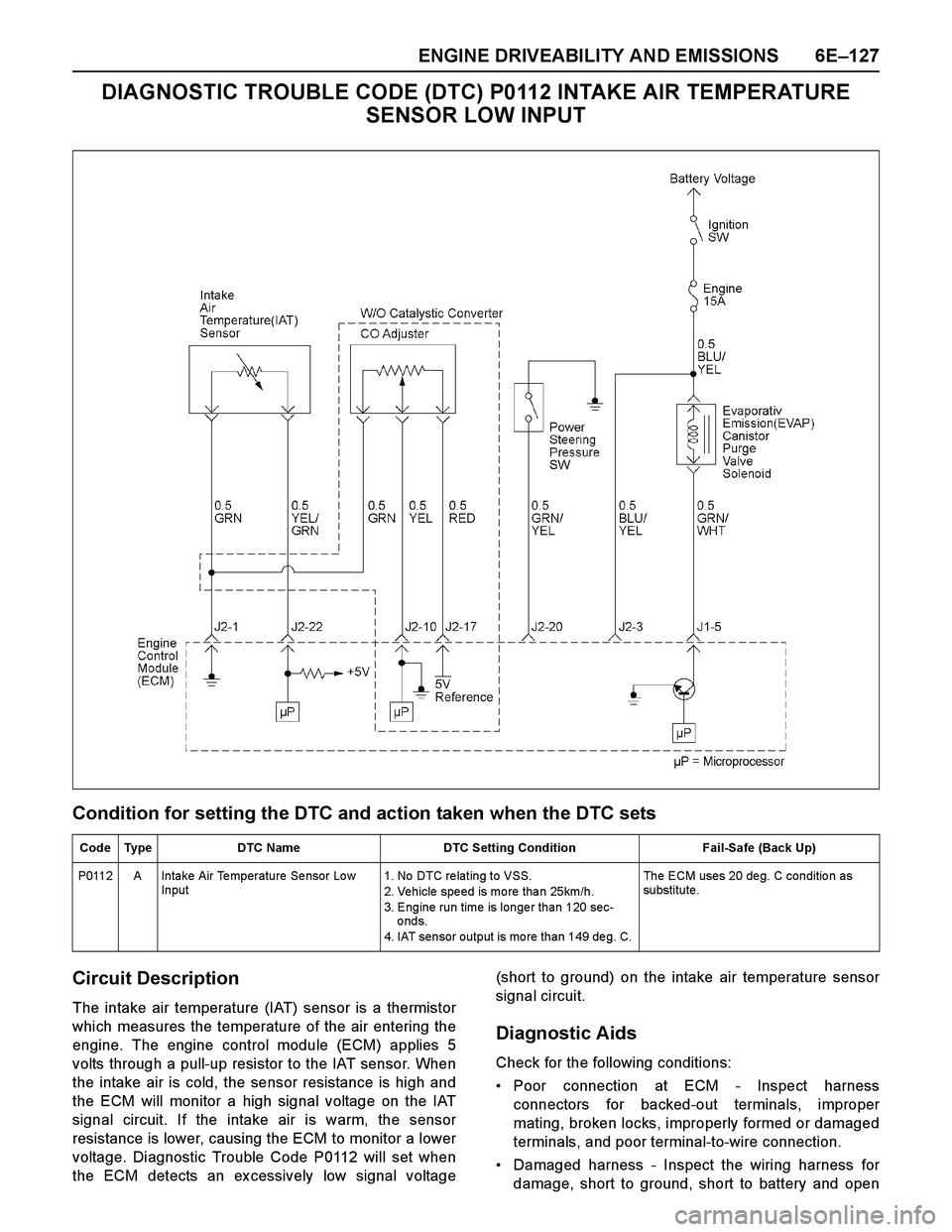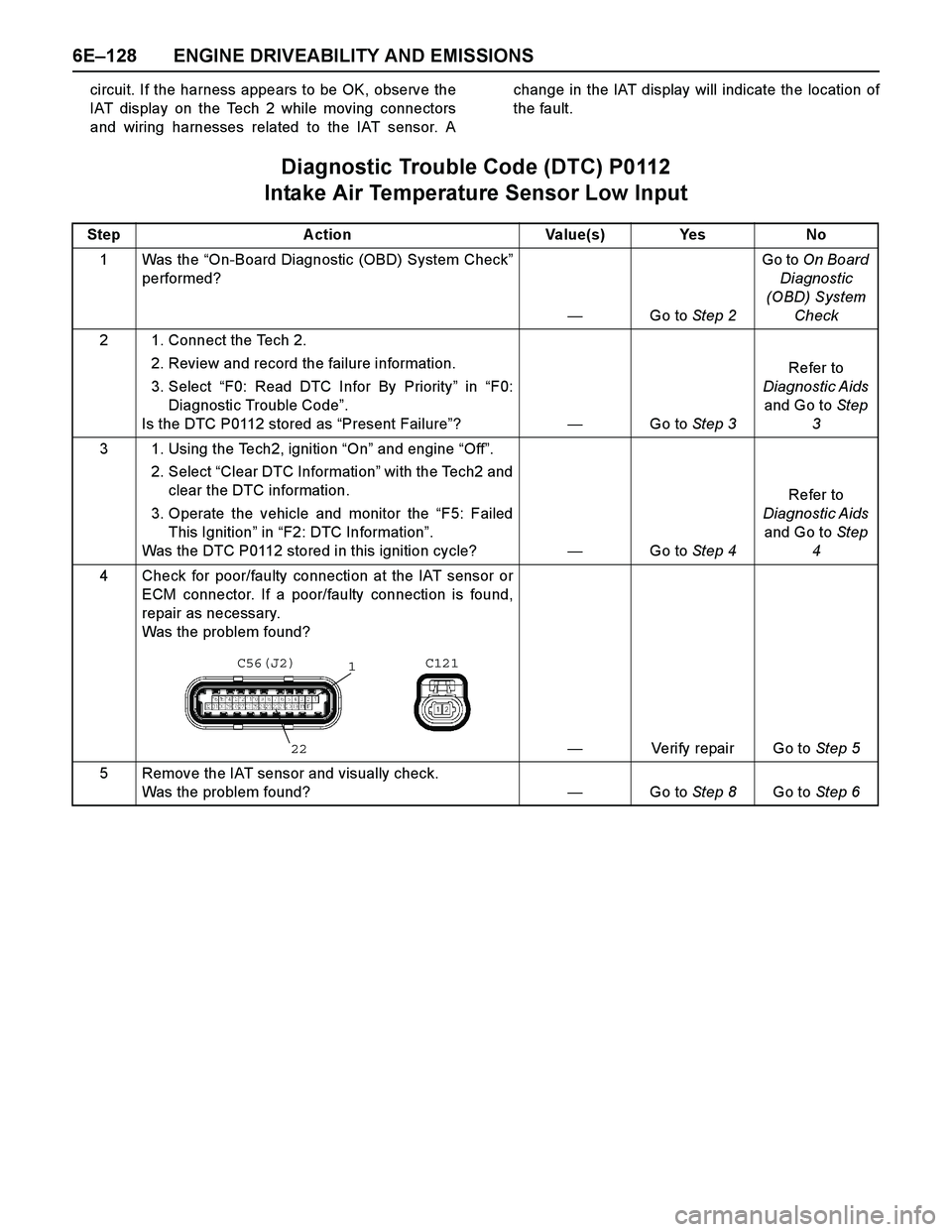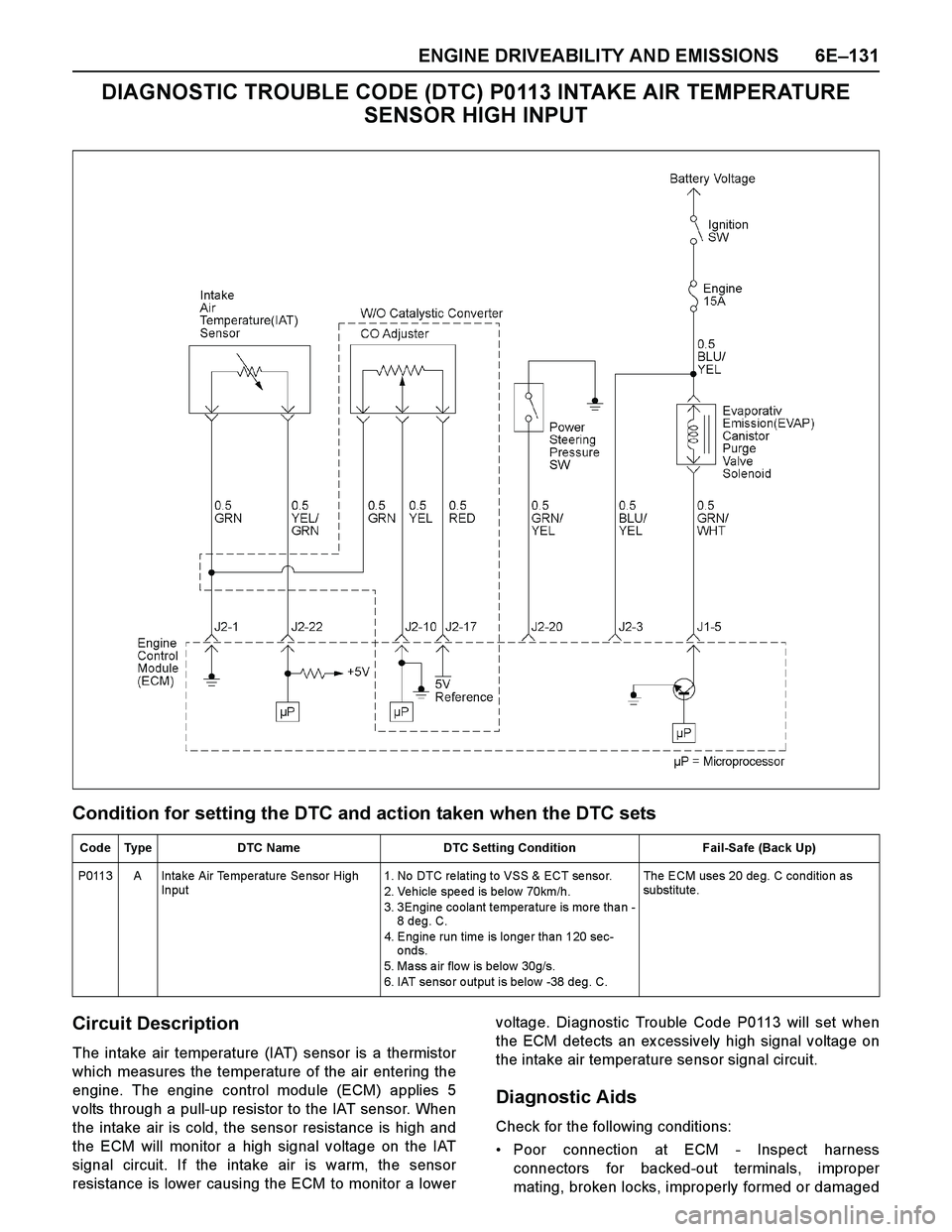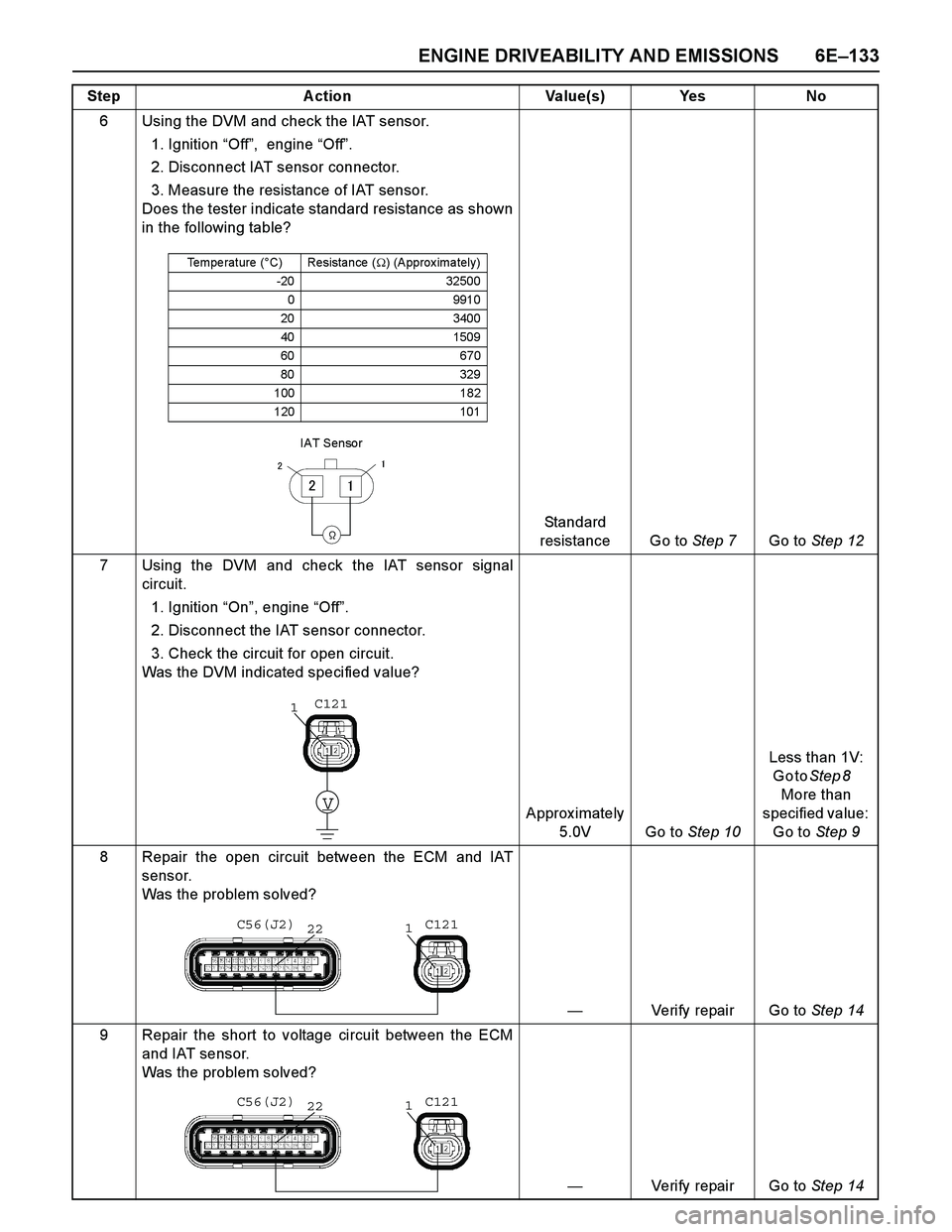Page 2702 of 4264

6E–126 ENGINE DRIVEABILITY AND EMISSIONS
10 Using the DVM and check the MAP sensor ground
circuit.
Breaker box is available:
1. Ignition “Off”, engine “Off”.
2. Install the breaker box as type A. (ECM
disconnected) Refer to 6E-88 page.
3. Disconnect the MAP sensor connector.
4. Check the circuit for open circuit.
Was the problem found?
Breaker box is not available:
1. Ignition “Off”, engine “Off”.
2. Disconnect the MAP sensor connector and ECM
connector.
3. Check the circuit for open circuit.
Was the problem found?
—Repair faulty
harness and
verify repair Go to Step 11
11 Substitute a known good MAP sensor and recheck.
Was the problem solved?—Go to Step 12 Go to Step 13
12 Replace the MAP sensor.
Is the action complete?—Verify repair—
13 Is the ECM programmed with the latest software
release?
If not, download the latest software to the ECM using
the “SPS (Service Programming System)”.
Was the problem solved?—Verify repair Go to Step 14
14 Replace the ECM.
Is the action complete?
IMPORTANT: The replacement ECM must be
programmed. Refer to section of the Service
Programming System (SPS) in this manual.
Following ECM programming, the immobilizer system
(if equipped) must be linked to the ECM. Refer to
section 11 “Immobilizer System-ECM replacement” for
the ECM/Immobilizer linking procedure.—Verify repair— Step Action Value(s) Yes No
J1-16
Breaker Box
�
E-85
�
116E85 E60(J1)
Page 2703 of 4264

ENGINE DRIVEABILITY AND EMISSIONS 6E–127
DIAGNOSTIC TROUBLE CODE (DTC) P0112 INTAKE AIR TEMPERATURE
SENSOR LOW INPUT
Condition for setting the DTC and action taken when the DTC sets
Circuit Description
The intake air temperature (IAT) sensor is a thermistor
which measures the temperature of the air entering the
engine. The engine control module (ECM) applies 5
volts through a pull-up resistor to the IAT sensor. When
the intake air is cold, the sensor resistance is high and
the ECM will monitor a high signal voltage on the IAT
signal circuit. If the intake air is warm, the sensor
resistance is lower, causing the ECM to monitor a lower
voltage. Diagnostic Trouble Code P0112 will set when
the ECM detects an ex cessively low signal voltage(short to ground) on the intake air temperature sensor
signal circuit.
Diagnostic Aids
Check for the following conditions:
Poor connection at ECM - Inspect harness
connectors for backed-out terminals, improper
mating, broken locks, improperly formed or damaged
terminals, and poor terminal-to-wire connection.
Damaged harness - Inspect the wiring harness for
damage, short to ground, short to battery and open
Code Type DTC Name DTC Setting Condition Fail-Safe (Back Up)
P0112 A Intake Air Temperature Sensor Low
Input1. No DTC re lating to VSS.
2. Vehicle spe ed is mo re tha n 25km/h.
3. Engine run time is longer than 120 sec-
onds.
4. IAT sensor output is more than 149 deg. C. The ECM uses 20 de g. C conditio n as
substitute.
Page 2704 of 4264

6E–128 ENGINE DRIVEABILITY AND EMISSIONS
circuit. If the harness appears to be OK, observe the
IAT display on the Tech 2 while moving connectors
and wiring harnesses related to the IAT sensor. Achange in the IAT display will indicate the location of
the fault.
Diagnostic Trouble Code (DTC) P0112
Intake Air Temperature Sensor Low Input
Step A ction Value(s) Yes No
1 Was the “On-Board Diagnostic (OBD) System Check”
performed?
—Go to Step 2Go to On Board
Diagnostic
(OBD) System
Check
2 1. Connect the Tech 2.
2. Review and record the failure information.
3. Select “F0: Read DTC Infor By Priority” in “F0:
Diagnostic Trouble Code”.
Is the DTC P0112 stored as “Present Failure”?—Go to Step 3Refer to
Diagnostic Aids
and Go to Step
3
3 1. Using the Tech2, ignition “On” and engine “Off”.
2. Select “Clear DTC Information” with the Tech2 and
clear the DTC information.
3. Operate the vehicle and monitor the “F5: Failed
This Ignition” in “F2: DTC Information”.
Was the DTC P0112 stored in this ignition cycle?—Go to Step 4Refer to
Diagnostic Aids
and Go to Step
4
4 Check for poor/faulty connection at the IAT sensor or
ECM connector. If a poor/faulty connection is found,
repair as necessary.
Was the problem found?
—Verify repair Go to Step 5
5 Remove the IAT sensor and visually check.
Was the problem found? —Go to Step 8Go to Step 6
C56(J2) C121
1
22
Page 2705 of 4264

ENGINE DRIVEABILITY AND EMISSIONS 6E–129
6 Using the DVM and check the IAT sensor.
1. Ignition “Off”, engine “Off”.
2. Disconnect IAT sensor connector.
3. Measure the resistance of IAT sensor.
Does the tester indicate standard resistance as shown
in the following table?
Standard
resistance Go to Step 7Go to Step 8
7 Using the DVM and check the IAT sensor signal
circuit.
Breaker box is available:
1. Ignition “Off”, engine “Off”.
2. Install the breaker box as type A. (ECM
disconnected) Refer to 6E-88 page.
3. Disconnect the IAT sensor connector.
4. Check the circuit for short to sensor ground or
ground circuit.
Was the problem found?
Breaker box is not available:
1. Ignition “Off”, engine “Off”.
2. Disconnect the IAT sensor connector.
3. Check the circuit for short to sensor ground or
ground circuit.
Was the problem found?
—Repair faulty
harness and
verify repair Go to Step 10 Step A ction Value(s) Yes No
Tempe rature (°C) Resistance (�) (Approx ima tely)
-20 32500
0 9910
20 3400
40 1509
60 670
80 329
100 182
120 101
��
IAT Sensor
�
��
J2 -1J2-22 Breaker Box
�
�
C56(J2)
122
Page 2706 of 4264
6E–130 ENGINE DRIVEABILITY AND EMISSIONS
8 Substitute a known good IAT sensor assembly and
recheck.
Was the problem solved?—Go to Step 9Go to Step 10
9 Replace the IAT sensor assembly.
Is the action complete?—Veri fy repai r—
10 Is the ECM programmed with the latest software
release?
If not, download the latest software to the ECM using
the “SPS (Service Programming System)”.
Was the problem solved?—Verify repair Go to Step 11
11 Replace the ECM.
Is the action complete?
IMPORTANT: The replacement ECM must be
programmed. Refer to section of the Service
Programming System (SPS) in this manual.
Following ECM programming, the immobilizer system
(if equipped) must be linked to the ECM. Refer to
section 11 “Immobilizer System-ECM replacement” for
the ECM/Immobilizer linking procedure.—Veri fy repai r— Step A ction Value(s) Yes No
Page 2707 of 4264

ENGINE DRIVEABILITY AND EMISSIONS 6E–131
DIAGNOSTIC TROUBLE CODE (DTC) P0113 INTAKE AIR TEMPERATURE
SENSOR HIGH INPUT
Condition for setting the DTC and action taken when the DTC sets
Circuit Description
The intake air temperature (IAT) sensor is a thermistor
which measures the temperature of the air entering the
engine. The engine control module (ECM) applies 5
volts through a pull-up resistor to the IAT sensor. When
the intake air is cold, the sensor resistance is high and
the ECM will monitor a high signal voltage on the IAT
signal circuit. If the intake air is warm, the sensor
resistance is lower causing the ECM to monitor a lowervoltage. Diagnostic Trouble Code P0113 will set when
the ECM detects an ex cessively high signal voltage on
the intake air temperature sensor signal circuit.
Diagnostic Aids
Check for the following conditions:
Poor connection at ECM - Inspect harness
connectors for backed-out terminals, improper
mating, broken locks, improperly formed or damaged
Code Type DTC Name DTC Setting Condition Fail-Safe (Back Up)
P0113 A Intake Air Temperature Sensor High
Input1. No DTC re lating to VSS & ECT se nso r.
2. Vehicle speed is below 70km/h.
3. 3Engine coolant temperature is more than -
8 deg. C.
4. Engine run time is longer than 120 sec-
onds.
5. Ma ss a ir flo w is below 30g/s.
6. IAT sensor output is below -38 deg. C. The ECM uses 20 de g. C conditio n as
substitute.
Page 2708 of 4264

6E–132 ENGINE DRIVEABILITY AND EMISSIONS
terminals, and poor terminal-to-wire connection.
Damaged harness - Inspect the wiring harness for
damage, short to ground, short to battery positive,
and open circuit. If the harness appears to be OK,observe the IAT display on the Tech 2 while moving
connectors and wiring harnesses related to the IAT
sensor. A change in the IAT display will indicate the
location of the fault.
Diagnostic Trouble Code (DTC) P0113
Intake Air Temperature Sensor High Input
Step A ction Value(s) Yes No
1 Was the “On-Board Diagnostic (OBD) System Check”
performed?
—Go to Step 2Go to On Board
Diagnostic
(OBD) System
Check
2 1. Connect the Tech 2.
2. Review and record the failure information.
3. Select “F0: Read DTC Infor By Priority” in “F0:
Diagnostic Trouble Code”.
Is the DTC P0113 stored as “Present Failure”?—Go to Step 3Refer to
Diagnostic Aids
and Go to Step
3
3 1. Using the Tech2, ignition “On” and engine “Off”.
2. Select “Clear DTC Information” with the Tech2 and
clear the DTC information.
3. Operate the vehicle and monitor the “F5: Failed
This Ignition” in “F2: DTC Information”.
Was the DTC P0113 stored in this ignition cycle?—Go to Step 4Refer to
Diagnostic Aids
and Go to Step
4
4 Check for poor/faulty connection at the IAT sensor or
ECM connector. If a poor/faulty connection is found,
repair as necessary.
Was the problem found?
—Verify repair Go to Step 5
5 Visually check the IAT sensor.
Was the problem found? —Go to Step 12Go to Step 6
C56(J2) C121
1
22
Page 2709 of 4264

ENGINE DRIVEABILITY AND EMISSIONS 6E–133
6 Using the DVM and check the IAT sensor.
1. Ignition “Off”, engine “Off”.
2. Disconnect IAT sensor connector.
3. Measure the resistance of IAT sensor.
Does the tester indicate standard resistance as shown
in the following table?
Standard
resistance Go to Step 7Go to Step 12
7 Using the DVM and check the IAT sensor signal
circuit.
1. Ignition “On”, engine “Off”.
2. Disconnect the IAT sensor connector.
3. Check the circuit for open circuit.
Was the DVM indicated specified value?
Approx imately
5.0V Go to Step 10Less than 1V:
Go to Step 8
More than
specified value:
Go to Step 9
8 Repair the open circuit between the ECM and IAT
sensor.
Was the problem solved?
—Verify repair Go to Step 14
9 Repair the short to voltage circuit between the ECM
and IAT sensor.
Was the problem solved?
—Verify repair Go to Step 14 Step A ction Value(s) Yes No
Temperature (°C) Resistance (�) (Approx ima tely)
-20 32500
0 9910
20 3400
40 1509
60 670
80 329
100 182
120 101
��
IAT Sensor
�
��
V
C121
1
C56(J2) C121
122
C56(J2) C121
122